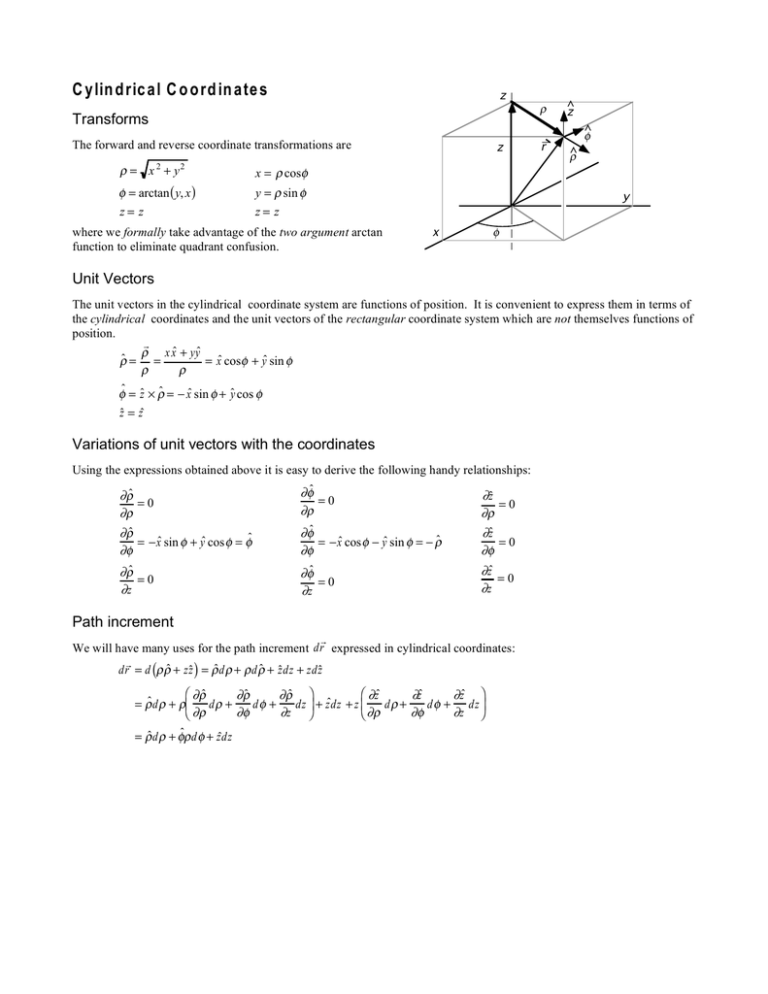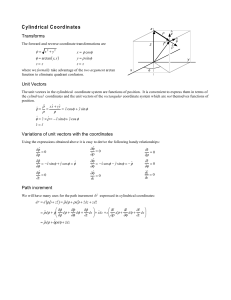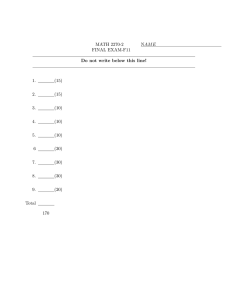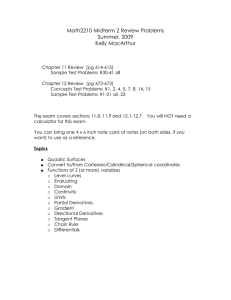Cylindrical Coordinates
advertisement

Cylindrical Coordinates z Transforms z The forward and reverse coordinate transformations are != x +y 2 2 " = arctan ( y, x ) z= z ! r ^ z ^ " ^ ! x = ! cos" y = ! sin " z= z where we formally take advantage of the two argument arctan function to eliminate quadrant confusion. y " x Unit Vectors The unit vectors in the cylindrical coordinate system are functions of position. It is convenient to express them in terms of the cylindrical coordinates and the unit vectors of the rectangular coordinate system which are not themselves functions of position. ! ! x xˆ + yyˆ !ˆ = = = xˆ cos" + yˆ sin " ! ! "ˆ = ˆz # !ˆ = $ xˆ sin " + ˆy cos " ˆz = zˆ Variations of unit vectors with the coordinates Using the expressions obtained above it is easy to derive the following handy relationships: !"ˆ =0 !" !"ˆ = $ xˆ sin # + yˆ cos # = #ˆ !# !"ˆ =0 !z !"ˆ =0 !# !"ˆ = $ xˆ cos " $ yˆ sin " = $ #ˆ !" !"ˆ =0 !z !ˆz =0 !" !ˆz =0 !# !zˆ =0 !z Path increment ! We will have many uses for the path increment dr expressed in cylindrical coordinates: ! dr = d (! !ˆ + zˆz) = !ˆ d! + ! d!ˆ + ˆzdz + zdˆz $ "!ˆ $ "zˆ "!ˆ "!ˆ ' "zˆ "zˆ ' = !ˆ d! + !& d! + d# + dz ) + zˆdz + z & d! + d# + dz) "! "# " z "! "# "z ( % ( % = !ˆ d! + #ˆ! d# + zˆdz Time derivatives of the unit vectors We will also have many uses for the time derivatives of the unit vectors expressed in cylindrical coordinates: "!ˆ ˙ "!ˆ ˙ "!ˆ !˙ˆ = !+ #+ z˙ = #ˆ#˙ "! "# "z ˙ "#ˆ ˙ "#ˆ ˙ "#ˆ #ˆ = !+ #+ z˙ = $ !ˆ #˙ "! "# "z ˙zˆ = "zˆ !˙ + "ˆz #˙ + "zˆ z˙ = 0 "! "# "z Velocity and Acceleration The velocity and acceleration of a particle may be expressed in cylindrical coordinates by taking into account the associated rates of change in the unit vectors: ! ! v = r˙ = !ˆ˙ ! + !ˆ !˙ + ˙zˆ z + zˆz˙ = !ˆ!˙ + "ˆ!"˙ + zˆz˙ ! v = !ˆ !˙ + "ˆ! "˙ + zˆz˙ ! ! ˙ a = v˙ = !˙ˆ !˙ + !ˆ !˙˙ + "ˆ !"˙ + "ˆ!˙ "˙ + "ˆ!"˙˙+ z˙ˆz˙ + zˆz˙˙ = "ˆ"˙!˙ + !ˆ ˙!˙ # !ˆ !"˙ 2 + "ˆ!˙ "˙ + "ˆ! "˙˙ + ˆz˙z˙ ( ) ( ) ! a = !ˆ !˙˙ " !#˙ 2 + #ˆ ! #˙˙ + 2 !˙ #˙ + zˆz˙˙ The del operator from the definition of the gradient Any (static) scalar field u may be considered to be a function of the cylindrical coordinates ! , ! , and z. The value of u ! changes by an infinitesimal amount du when the point of observation is changed by dr . That change may be determined from the partial derivatives as du = !u !u !u d" + d# + dz . !" !# !z But we also define the gradient in such a way as to obtain the result ! ! du = !u " dr Therefore, ! !u !u !u ! d" + d# + dz = $u % dr !" !# !z or, in cylindrical coordinates, ! ! ! !u !u !u d" + d# + dz = $u d" + $u " d# + $u dz " # z !" !# !z ( ) ( ) ( ) and we demand that this hold for any choice of d ! , d! and dz. Thus, ! (! u) " = #u , #" ! ( !u) $ = from which we find ! # $ˆ # # ! = "ˆ + + ˆz #" " #$ #z 1 #u , " #$ ! (!u ) z = #u , #z Divergence ! ! The divergence ! " A is carried out taking into account, once again, that the unit vectors themselves are functions of the coordinates. Thus, we have ! ! & $ %ˆ $ $) ! " A = ( #ˆ + + zˆ + " A# #ˆ + A% %ˆ + Az zˆ $z * ' $# # $% ( ) where the derivatives must be taken before the dot product so that ! ! & $ %ˆ $ ˆ $ ) ! ! " A = ( #ˆ + +z +"A $z * ' $# # $% ! ! ! $A %ˆ $A $A ˆ =#" + " + zˆ " $# # $% $z & $A# $A% ˆ $Az $#ˆ $%ˆ $zˆ ) ˆz + A# = #ˆ " ( #ˆ + %+ + A% + Az + $# $# $# $# $# * ' $# %ˆ & $A# ˆ $A% ˆ $Az $#ˆ $%ˆ $zˆ ) + "( #+ %+ zˆ + A# + A% + Az # ' $% $% $% $% $% $% +* & $A $A $A $#ˆ $%ˆ $ˆz ) + zˆ " ( # #ˆ + % %ˆ + z zˆ + A# + A% + Az + $z $z $z $z $z * ' $z With the help of the partial derivatives previously obtained, we find ! ! $A & $A ) $A ! " A = #ˆ " ( # #ˆ + % %ˆ + z ˆz + 0 + 0 + 0+ $# $# ' $# * ) %ˆ & $A# ˆ $A% ˆ $Az ˆ + "( #+ %+ z + A#%ˆ , A% #ˆ + 0+ # ' $% $% $% * & $A# $A% ˆ $Az ) + zˆ " ( #ˆ + %+ zˆ + 0 + 0 + 0+ $z $z ' $z * & $A# ) & 1 $A% A# ) & $Az ) =( + + ++( ++( # * ' $z * ' $# * ' # $% & $A# A# ) 1 $A% $Az =( + + + # +* # $% $z ' $# ! ! 1 $ 1 $A% $Az !"A = A# # + + # $# # $% $z ( ) Curl ! ! The curl ! " A is also carried out taking into account that the unit vectors themselves are functions of the coordinates. Thus, we have ! ! & $ %ˆ $ $) ! " A = ( #ˆ + + ˆz + " A# #ˆ + A% %ˆ + Az zˆ $z * ' $# # $% ( ) where the derivatives must be taken before the cross product so that ! ! & $ %ˆ $ ˆ $ ) ! ! " A = ( #ˆ + +z +"A $z * ' $# # $% ! ! ! $A %ˆ $A $A ˆ = #" + " + zˆ " $# # $% $z & $A# $A% ˆ $Az $#ˆ $%ˆ $zˆ ) = #ˆ " ( #ˆ + %+ zˆ + A# + A% + Az + $# $# $# $# $# * ' $# %ˆ & $A# ˆ $A% ˆ $Az $#ˆ $%ˆ $zˆ ) + "( #+ %+ zˆ + A# + A% + Az # ' $% $% $% $% $% $% +* & $A $A $A $#ˆ $%ˆ $zˆ ) + ˆz " ( # #ˆ + % %ˆ + z ˆz + A# + A% + Az + $z $z $z $z $z * ' $z With the help of the partial derivatives previously obtained, we find ! ! & $A# $A% ˆ $Az ) ! " A = #ˆ " ( #ˆ + %+ zˆ + 0 + 0 + 0+ $# $# ' $# * $A ) %ˆ & $A $A + " ( # #ˆ + % %ˆ + z zˆ + A#%ˆ , A% #ˆ + 0+ # ' $% $% $% * & $A# $A% ˆ $Az ) ˆz + 0 + 0 + 0+ + ˆz " ( #ˆ + %+ $z $z ' $z * & $A $A = ( % ˆz , z $# ' $# ) %ˆ + * & 1 $A# 1 $Az ˆ A% ) + (, zˆ + #+ zˆ+ # $% # * ' # $% & $A# ˆ $A% ) +( %, #ˆ + $z * ' $z & 1 $Az $A% ) ˆ & $A# $Az ) & $A% A% 1 $A# ) = #ˆ ( , , + , + + %( + + zˆ( $z * $# * ' $# # # $% +* ' # $% ' $z ! ! ' 1 $Az $A% * ˆ ' $A# $Az * '1 $ 1 $A# * ! " A = #ˆ ) & + %) & + zˆ) A% # & , , $z + $# + ( # $# # $% ,+ ( # $% ( $z ( ) Laplacian The Laplacian is a scalar operator that can be determined from its definition as ! ! & $ %ˆ $ $ ) & $u %ˆ $u $u ) ! 2 u = ! " !u = ( #ˆ + + zˆ + " ( #ˆ + + zˆ + $z * ' $# # $% $z * ' $# # $% $ & ˆ $u %ˆ $u ˆ $u ) = #ˆ " + +z + (# $# ' $# # $% $z * ( ) + %ˆ $ & ˆ $u %ˆ $u ˆ $u ) " + +z + (# # $% ' $# # $% $z * + zˆ " $ $z & $u %ˆ $u $u ) + + zˆ + ( #ˆ $z * ' $# # $% With the help of the partial derivatives previously obtained, we find ' $ 2u &ˆ $u &ˆ $ 2u $ 2u * ! 2 u = "ˆ # ) "ˆ 2 % 2 + + zˆ , " $& " $&$" $z$" + ( $" + &ˆ ' ˆ $u ˆ $ 2 u "ˆ $u &ˆ $ 2 u $ 2u * # )& +" % + + zˆ , 2 " ( $" $"$& " $& " $& $z$& + ' $ 2 u &ˆ $ 2 u $ 2u * + zˆ # ) "ˆ + + zˆ 2 , $z + ( $"$z " $&$z = $ 2 u 1 $u 1 $ 2 u $ 2 u + + + $" 2 " $" " 2 $& 2 $z2 = 1 $ ' $u * 1 $ 2u $ 2u + )" , + 2 " $" ( $" + " $& 2 $z 2 Thus, the Laplacian operator can be written as !2 = 1 # $ # ' 1 #2 #2 + &" ) + 2 " #" % #" ( " #* 2 #z 2



![MA1S11 (Timoney) Tutorial/Exercise sheet 1 [due Monday October 1, 2012] 1. 5](http://s2.studylib.net/store/data/010731543_1-3a439a738207ec78ae87153ce5a02deb-300x300.png)

